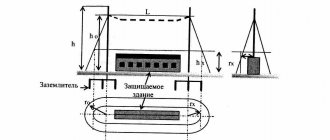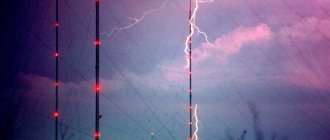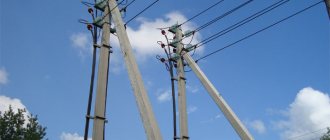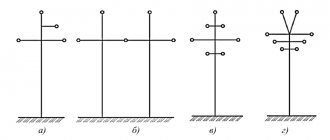It is hardly worth telling our reader how destructive the power of the elements can be. Tens of thousands of people die from lightning strikes every year, but even without human casualties, the consequences of a direct lightning strike on a house can be terrible. The situation is aggravated by the fact that the current residential infrastructure is a concentration of surge-sensitive electronic equipment, and even indirect exposure to a powerful electrical discharge can cause the failure of a large number of household appliances.
A lightning protection device for a building, be it a private house or a high-rise building, will help prevent such scenarios.
Is lightning protection necessary for houses with a metal roof?
Metal tiles are one of the most popular modern roofing materials, actually displacing classic slate. Corrugated sheeting is not far behind; seam roofing varieties made of sheet metal, copper or steel are still in demand.
There is an opinion that a metal roof does not need lightning protection - firstly, it itself is a lightning rod, and secondly, metal does not burn, so the risk of a fire from a lightning strike is reduced to nothing.
Both statements are incorrect. As for fire hazards, in most cases metal structures are laid on wooden sheathing or on flammable heat or waterproofing materials.
A metal roof is also not a lightning rod, since the huge potential difference in the event of a direct lightning strike without grounding does not go away, focusing on the edges of the roof and leading to melting and fires.
However, installing a lightning rod on a metal roof is also not the best option; the optimal method of lightning protection for a metal roof is its high-quality grounding, which among professionals is called a potential equation system.
What are the dangers of not being grounded?
The consequences of a disaster can be very diverse: failure of electrical appliances and electric shock to people in the house. In addition, lightning striking the roof can cause a fire. Proper grounding of the roof of the house will help to avoid all of the above.
First of all, houses whose roofs are made of metal and lightweight rolled materials are at risk. Such roofs must be grounded at the construction stage, before the house is put into operation. This is due to the following reasons:
- the metal roof of a house can attract electricity;
- soft roofing can catch fire when hit by a random spark.
Thus, it is necessary to install a lightning rod in any building, especially if it is built of wood. But before you begin work, you need to carefully study all the nuances of grounding installation. This is due to the fact that grounding installation must be carried out taking into account many factors, for example, roofing material.
Classification of types of lightning protection of buildings
Based on the materials used and type of construction, lightning protection of buildings is divided into the following types:
- rod (pin);
- cable;
- mesh.
Lightning protection for pitched roofs, which is considered the most common, is most often equipped with a rod or cable type. For multi-level roofs, it is recommended to combine any two types of lightning protection.
Pin system
A vertical metal pin acts as a lightning rod here. Certain requirements are imposed on it - it must be light, but durable, and characterized by resistance to atmospheric factors.
If the roof area is large, you can install several of these lightning rods. It is important that they are attached to the highest points of the roof and rise above them by at least 1.5 meters. It is possible to install the mast separately from the building, but then it is important to calculate its height: the lightning rod creates a protection zone around itself in the form of a cone, and the roof of the building must completely fall within this cone.
Cable lightning rods
This type of protection is applied to pitched roofs, since a metal cable is mounted above the ridge along its entire length. Excellent results are demonstrated by combined protection when the cable is tensioned between two pins. This option is recommended for buildings whose roof length is much greater than its width. Among the requirements for such a design, we note that the diameter of the steel cable must be at least 1.2 cm, and this indicator depends on the length of the roof ridge. To prevent the cable from sagging due to external factors (for example, icing), it is advisable to use intermediate fasteners.
Instead of a cable, it is allowed to use steel wire rod mounted to the supports by welding or clamps.
Mesh lightning protection
The best option for flat roofs. Made from wire with a diameter of 1 cm, it is characterized by high material consumption and labor-intensive installation.
In principle, this type of lightning protection can also be used in relation to pitched roofs - if you do not take into account the high cost and labor costs, then mesh protection is considered the most reliable.
Cable lightning rods
When protecting a private house from lightning, on the roof of which standard slate sheets are laid, for example, it is most convenient to use the so-called cable lightning rod.
The basis of such lightning protection is a cable stretched along the ridge or a thick steel wire placed at a distance of about half a meter from it.
All other elements of the lightning protection design are made exactly the same as in the previous case. To secure the down conductor to the slope of a slate roof, it is recommended to use special brackets with rubber gaskets to prevent moisture from penetrating under the covering.
How to install lightning protection on a flat roof
As we have already noted, installing lightning protection on a flat roof or a roof with a minimum angle of inclination is a much more labor-intensive operation than for a pitched one. Typically, a metal mesh with certain mesh sizes is used for this. If there are protruding structural elements (ventilation ducts, elevator superstructures), their lightning protection is carried out using the classic pin method.
Methods for constructing external lightning protection for a flat roof
A typical lightning protection design for buildings with a low-slope or flat roof is applicable here only in the context of the fact that during the design it is necessary to take into account the topology of the roof - lightning rods should be placed in such a way as to protect not only the roof itself, but also all structural elements, as well as equipment installed on the roof.
It is permissible to install the mesh under the waterproofing layer, provided that it is a non-flammable material. If the mesh is laid on top, then on special holders so that the rods are at a height of about 10 cm from the waterproofing layer.
Lightning protection mesh on the roof
The task of laying mesh on a flat roof may seem trivial only at first glance. In fact, wire rod with a diameter of up to 10 mm tends to bend. Considering the requirements for lightning protection mesh (cells with a side of 5-10 cm), it may be necessary to use a special tool to align hot-rolled wire. You will also need stands for the mesh.
Lightning rod holders for flat roofs
There are two types of fastening lightning protection to the roof:
- hollow, which are filled with frost-resistant types of concrete;
- factory-made, with a load, weighing about 1 kg, in the form of a rectangle or round shape.
Of course, the holders are not mounted under each cell - the recommended distance between adjacent stands is about a meter. The rule is simple: the thinner the wire, the smaller the interval between supports. If the holder is factory, then it has a latch for the wire.
The choice of a specific type of lightning protection mesh holder on a low-sloping/flat roof depends on two factors: ease of installation and the permissible weight load on the roof. If the mesh consists of several sections, they are connected by welding, bolting or any other method without loss of electrical conductivity.
Features of the design of flat roof barriers
Typically, a flat roof has a perimeter fence made of brick or concrete. To prevent the destruction of such a barrier from the effects of precipitation and lightning strikes, it is covered with galvanized metal, which, in turn, must be included in the general lightning protection circuit. If the down conductors of the mesh go to the façade, the connection between the atiki covering and the mesh occurs naturally.
When laying the lightning protection mesh, it is necessary to take into account that the connection of the down conductors with the grounding conductor must be made in full compliance with the requirements of safety standards, that is, such connections are filled with bitumen or a similar material with dielectric properties.
Lightning protection of equipment and roof structures
Note that the presence of communication elements on the roof also requires lightning protection - this applies to ventilation shafts, pipes, and other equipment.
At the same time, if the protected elements have metal parts, the lightning rod cannot be placed near them, so as not to provoke a discharge overflow. Otherwise, it is permissible to install the lightning rod directly on such elements.
Installation of lightning protection on a soft roof
The enormous popularity of metal tiles is associated with its high aesthetics, but its installation will require the mandatory installation of lightning protection for a house with a metal roof. Even more so for a wooden house.
Since such roofs are pitched, a pin or cable method of lightning protection, or a combination of both, is usually used here. The installation itself is divided into two stages: the installation of the lightning rod itself, this work is carried out directly on the roof, and the installation of the grounding loop is the ground part of the work.
Roof part
Let's take a closer look at both methods describing how to make lightning protection for a soft (metal) roof:
- in the case of the pin method, a metal rod is usually mounted on a ridge, and a current conductor goes from it to the ground, which is used as a wire with a diameter of 6 mm or more. The down conductor, in turn, is welded to a metal pin driven into the ground to a depth of at least 50 cm below the freezing level of the soil;
- Cable lightning protection involves installing a cable along the entire length of the ridge on low metal holders. The down conductor device is similar to the previous method.
There is also active lightning protection, a type of pin type, when a lightning-receiving head is installed on the top of the pin, which is an ion generator enclosed in a sealed housing. This scheme also requires a down conductor with a ground electrode.
A piece of reinforcement 1.5 m or more long can be used as a rod for a pin lightning rod. For a private house with a metal tile roof, two lightning rods are installed at different ends of the ridge.
The current conductor is made of wire with a diameter of 6 mm or more, or a bundle of galvanized wire welded to the rod.
Ground loop
A mandatory component of lightning protection for a soft roof is grounding of the down conductor. For this, metal rods with a diameter of at least 1.6 cm or hollow steel pipes with a diameter of at least 3.2 cm with a wall thickness of 3.0 mm are used. It is also possible to use corners or rectangular pipes with a cross-section of 10 cm with a wall thickness of 4 mm or more.
There must be at least three grounding conductors, their number is calculated based on the area of the building and the expected total load of electrical appliances.
All grounding conductors must be connected into a common bus; the method of connection with each other and with down conductors is welding.
The circuit is tested with an induction ohmmeter. To do this, the electrodes of the device are inserted into the ground at a distance of 10-12 meters from the ground loop. The distance between the electrodes should be about one and a half meters. The resistance value should be within 4 ohms.
In conclusion, we note that the presence of lightning protection on the roof does not eliminate the need to provide protection for household electrical appliances, which requires the installation of an internal grounding loop that can be integrated into a single circuit.
How to make grounding yourself
Grounding is made from a metal object of fairly large dimensions, having a large area. It should be buried to the maximum depth. So. As an object for grounding, you can use a piece of pipe or a rafter metal corner. Often they use a reinforcing mesh made of strong and thick wire, or a metal barrel; even a solid thick sheet or piece of iron will do.
Please note that it is necessary to bury the object for grounding to a depth that exceeds the depth of soil freezing.









